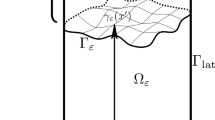Abstract
A possible explanation for the enhanced flow in carbon nanotubes is given using a mathematical model that includes a depletion layer with reduced viscosity near the wall. In the limit of large tubes the model predicts no noticeable enhancement. For smaller tubes the model predicts enhancement that increases as the radius decreases. An analogy between the reduced viscosity and slip-length models shows that the term slip-length is misleading and that on surfaces which are smooth at the nanoscale it may be thought of as a length-scale associated with the size of the depletion region and viscosity ratio. The model therefore provides a physical interpretation of the classical Navier slip condition and explains why ‘slip-lengths’ may be greater than the tube radius.
Similar content being viewed by others
References
Alexeyev AA, Vinogradova OI (1996) Flow of a liquid in a nonuniformly hydrophobized capillary. Colloids Surf A: Physicochem 108:173–179
Barrat J-L, Bocquet L (1999) Influence of wetting properties on hydrodynamic boundary conditions at a fluid/solid interface. Faraday Discuss 112:119–27
Bhushan B (ed) (2008) Springer handbook of nanotechnology. Springer, Berlin
Choi C-H, Westin JA, Breuer KS (2003) Apparent slip flows in hydrophilic and hydrophobic microchannels. Phys Fluids 15(10):2897–2902
Cottin-Bizonne C, Cross B, Steinberger A, Charlaix E (2005) Boundary slip on smooth hydrophobic surfaces: intrinsic effects and possible artifacts. Phys Rev Lett 94:056102
de Gennes PG (2002) On fluid/wall slippage. Langmuir 18:3413–3414
Denn MM (2001) Extrusion instabilities and wall slip. Annu Rev Fluid Mech 33:265–87
Eijkel JCT, van den Berg A (2005) Nanofluidics: what is it and what can we expect from it? Microfluid Nanofluid 1:249–267. doi:10.1007/s10404-004-0012-9
Holt JK, Park HG, Wang Y, Stadermann M, Artyukhin AB, Grigoropoulos CP, Noy A, Bakajin O (2006) Fast mass transport through sub-2-nanometer carbon nanotubes. Science 312:1034. doi:10.1126/science.1126298
Hummer G, Rasaiah JC, Noworyta JP (2001) Water conduction through the hydrophobic channel of a carbon nanotube. Nature 414(8):188–190
Joseph S, Aluru NR (2008) Why are carbon nanotubes fast transporters of water. Nano Lett 8(2):452–458
Majumder M, Chopra N, Andrews R, Hinds BJ (2005) Enhanced flow in carbon nanotubes. Nat Biotechnol 438:44
Matthews MT, Hill JM (2008) Nanofluidics and the Navier boundary condition. Int J Nanotechnol 5(2/3):218–242
Mattia D, Gogotsi Y (2008) Review: static and dynamic behavior of liquids inside carbon nanotubes. Microfluid Nanofluid 5:289–305. doi:10.1007/s10404-008-0293-5
Myers TG (1998) Thin films with high surface tension. SIAM Rev 40(3):441–462
Myers TG (2002) Modeling laminar sheet flow over rough surfaces. Water Resour Res 38:1230. doi:10.1029/2000WR000154
Myers TG (2005) Application of non-Newtonian models to thin film flow. Phys Rev E 72:066302
Neto C, Evans DR, Bonaccurso E, Butt H-J, Craig VSJ (2005) Boundary slip in Newtonian liquids: a review of experimental studies. Rep Prog Phys 68:2859–2897
Noya A et al (2007) Nanofluidics in carbon nanotubes. Nano Today 2(6):22–29
O’Donovan EJ, Tanner RI (1984) Numerical study of the Bingham squeeze film problem. J Non-Newton Fluid Mech 15:75–83
Orikasa H, Inokuma N, Okubo S, Kitakami O, Kyotani T (2006) Template synthesis of water-dispersible carbon nano ‘test tubes’ without any post-treatment. Chem Mater 18:1036–1040
Poynor A, Hong L, Robinson IK, Granick S (2006) How water meets a hydrophobic surface. Phys Rev Lett 97:266101-1–266101-4
Pozhar LA (2000) Structure and dynamics of nanofluids: theory and simulations to calculate viscosity. Phys Rev E 61(2):1432–1446
Qian T, Wang X-P, Sheng P (2004) Power-law slip profile of the moving contact line in two-phase immiscible flows. Phys Rev Lett 93(9):094501. doi:10.1103/PhysRevLett.93.094501
Ruckenstein E, Rajora P (1983) On the no-slip boundary condition of hydrodynamics. J Colloid Interface Sci 96(2):488–491
Thomas JA, McGaughey AJH (2008a) Reassessing fast water transport through carbon nanotubes. Nano Lett 8(9):2788–2793
Thomas JA, McGaughey AJH (2008b) Density, distribution, and orientation of water molecules inside and outside carbon nanotubes. J Chem Phys 128:084715. doi:10.1063/1.2837297
Travis KP, Todd BD, Evans DJ (1997) Departure from Navier-Stokes hydrodynamics in confined liquids. Phys Rev E 55(4):4288–4295
Tretheway DC, Meinhart CD (2002) Apparent fluid slip at hydrophobic microchannel walls. Phys Fluids 14(3):L9–12
Verdaguer A, Sacha GM, Bluhm H, Salmeron M (2006) Molecular structure of water at interfaces: wetting at the nanometer scale. Chem Rev 106:1478–1510
Verweij H, Schillo MC, Li J (2007) Fast mass transport through carbon nanotube membranes. Small 3(12):1996–2004. doi:10.1002/smll.200700368
Vinogradova OI (1995) Coagulation of hydrophobic and hydrophilic solids under dynamic conditions. J Colloid Interface Sci 169:306–12
Vinogradova OI (1999) Slippage of water over hydrophobic surfaces. Int J Miner Process 56:31–60
Whitby M, Cagnon L, Thanou M, Quirke N (2008) Enhanced fluid flow through nanoscale carbon pipes. Nano Lett 8(9):2632–2637
White FM (1991) Viscous fluid flow. McGraw-Hill, New York
Werder T et al (2001) Molecular dynamics simulation of contact angles of water droplets in carbon nanotubes. Nano Lett 1:697–702
Zhu Y, Granick S (2001) Rate-dependent slip of Newtonian liquids at smooth surfaces. Phys Rev Lett 87:96105
Acknowledgments
TM gratefully acknowledges the support of this research through the Marie Curie International Reintegration Grant Industrial applications of moving boundary problems, grant no. FP7—256417 and partial support by the project 2009-SGR-345 from AGAUR-Generalitat de Catalunya.
Author information
Authors and Affiliations
Corresponding author
Rights and permissions
About this article
Cite this article
Myers, T.G. Why are slip lengths so large in carbon nanotubes?. Microfluid Nanofluid 10, 1141–1145 (2011). https://doi.org/10.1007/s10404-010-0752-7
Received:
Accepted:
Published:
Issue Date:
DOI: https://doi.org/10.1007/s10404-010-0752-7




